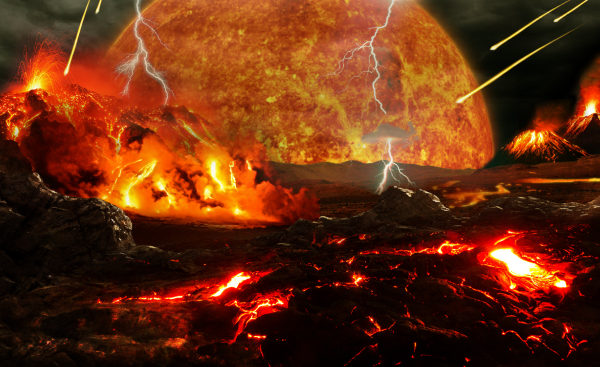How blockchain technology could help reveal the origins of life
"Maybe society could be happier about using cryptocurrencies if you could tell people that, in the process, we could discover new laws of biology or some new cancer drug."

A team of chemists has managed to harness blockchain technology — typically used to mine cryptocurrencies — and create a massive computer network that can investigate the emergence of life on Earth.
On one hand, this shows how blockchain can be employed to solve problems beyond those of the financial sector; on the other, this particular study might've discovered some leads for scientists hunting for our origins.
The crew's mechanism revealed that some primitive forms of metabolism — chemical reactions that happen in the cells of living things and change food into energy — might have emerged without the involvement of enzymes, or proteins that help speed up those reactions.
As for why the team used blockchain technology specifically to reach these conclusions?
Well, in general, investigating pre-life or "prebiotic" chemistry requires looking at as many as over 11 billion possible reactions between molecules. There are just so many permutations to deal with. As you can imagine, completing such a task in full would require a huge amount of computing power. Yet, the team behind the new discovery, led by Bartosz Grzybowsk of the Korea Institute for Basic Science and the Polish Academy of Sciences, lacked a supercomputer to conduct this kind of massive investigation. So, instead, they turned to what's known as "Golem."
Golem is a cryptocurrency-mining platform that orchestrates various calculations over hundreds of computers across the world, then exchanges cryptocurrency for computing time.
Related: Life as we know it may have its roots in an old, cold cosmic cloud
Breaking space news, the latest updates on rocket launches, skywatching events and more!
"It allows you to get computing power in return for this cryptocurrency. So, I could rent your idle computer time," Grzybowski told Space.com, emphasizing that he and the team have no investments in Golem. "We were looking for a way to boost our computing capability, and this is a worldwide computing scheme where we had thousands of people cooperating with us and granting us the use of around 20,000 CPUs all over the world."
First, the team created the Network of Early Life (NOEL) of starting molecules, or molecules likely to have been present on early Earth around 4 billion years ago, including water, methane and ammonia. Then, the researchers took the 11 billion possible prebiotic reactions laid out and trimmed the figure down to a more manageable 4.9 billion reactions.
Grzybowski explained that even after this reduction, however, NOEL still represented a network around 100,000 times bigger than the one used in the team's previous origins of life research, published in 2020.
Among the reactions possible in NOEL, some are parts of chemical reactions called "metabolic pathways." For instance, glycolysis is a metabolic pathway during which glucose is broken down to produce energy. Other reactions, by comparison, closely mimic the Krebs cycle, which living things use to generate energy; still others are ones that are capable of synthesizing biotic molecules like sugars and amino acids.
Via NOEL, the team discovered (to their surprise) that, of the billions of reactions they generated, only a few hundred saw molecules create copies of themselves.
"It's very, very rare. I was actually surprised by how rare it was, something like one reaction or one cycle in 1 million cycles could be self-replicating," Grzybowski explained.
This is extraordinary because this process of self-replication, or "auto amplification," has long been considered to be a crucial player in the emergence of life.
"For many decades, some chemists said even in the early stages of this chemical evolution, molecules might have had a propensity to form cycles that would give off additional copies of the same material," Grzybowski said. "Some molecules would replicate faster than others, and they create possible channels to take evolution in a certain direction."
He added that another camp of origin-of-life chemists argue that early pre-biotic molecules were too simple to replicate as complex modern biological molecules, such as DNA, do. Grzybowski thinks this investigation could settle that debate as it indicates, to his surprise, that self-replication didn't happen before the evolution of much larger molecules.
"Although we don't see it with the origins of life, I'm still not giving up on this idea of self-replication," Grzybowski continued. "It must have appeared at some point because we know that now biology self-replicates, but the question is at which stage of their complexity did molecules start replicating?"
As for the use of Golem to create massive and powerful computer networks?
Grzybowski thinks this could be widely employed by researchers without access to a supercomputer, who need to perform a vast amount of calculations.
"There are many more scientists that are not privileged enough to have their own supercomputer. They can hook up on a platform like Golem distributed all over the world and get these kinds of resources at their disposal," he concluded. "Maybe society could be happier about using cryptocurrencies if you could tell people that, in the process, we could discover new laws of biology or some new cancer drug."
The team's research was published on Jan. 24 in the journal Chem.

Robert Lea is a science journalist in the U.K. whose articles have been published in Physics World, New Scientist, Astronomy Magazine, All About Space, Newsweek and ZME Science. He also writes about science communication for Elsevier and the European Journal of Physics. Rob holds a bachelor of science degree in physics and astronomy from the U.K.’s Open University. Follow him on Twitter @sciencef1rst.
